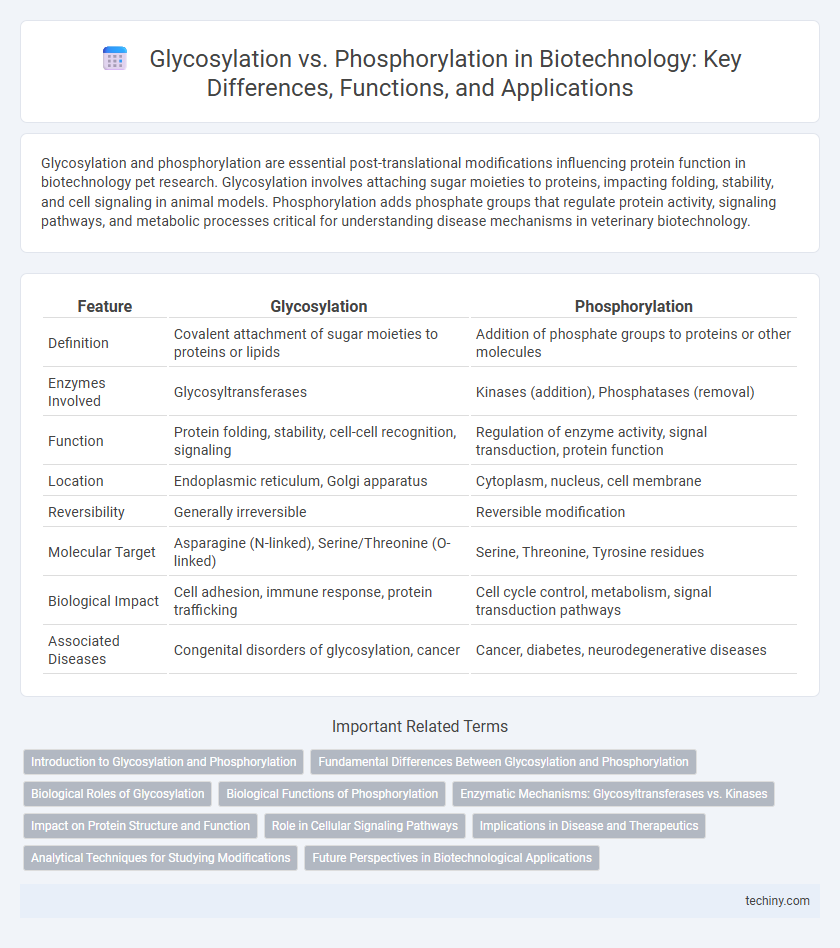Glycosylation and phosphorylation are essential post-translational modifications influencing protein function in biotechnology pet research. Glycosylation involves attaching sugar moieties to proteins, impacting folding, stability, and cell signaling in animal models. Phosphorylation adds phosphate groups that regulate protein activity, signaling pathways, and metabolic processes critical for understanding disease mechanisms in veterinary biotechnology.
Table of Comparison
| Feature | Glycosylation | Phosphorylation |
|---|---|---|
| Definition | Covalent attachment of sugar moieties to proteins or lipids | Addition of phosphate groups to proteins or other molecules |
| Enzymes Involved | Glycosyltransferases | Kinases (addition), Phosphatases (removal) |
| Function | Protein folding, stability, cell-cell recognition, signaling | Regulation of enzyme activity, signal transduction, protein function |
| Location | Endoplasmic reticulum, Golgi apparatus | Cytoplasm, nucleus, cell membrane |
| Reversibility | Generally irreversible | Reversible modification |
| Molecular Target | Asparagine (N-linked), Serine/Threonine (O-linked) | Serine, Threonine, Tyrosine residues |
| Biological Impact | Cell adhesion, immune response, protein trafficking | Cell cycle control, metabolism, signal transduction pathways |
| Associated Diseases | Congenital disorders of glycosylation, cancer | Cancer, diabetes, neurodegenerative diseases |
Introduction to Glycosylation and Phosphorylation
Glycosylation and phosphorylation are critical post-translational modifications that regulate protein function and cellular processes. Glycosylation involves the enzymatic attachment of carbohydrate moieties to proteins or lipids, influencing protein folding, stability, and cell signaling. Phosphorylation entails the addition of phosphate groups by kinases, modulating enzyme activity, signal transduction, and metabolic pathways essential in biotechnology and disease research.
Fundamental Differences Between Glycosylation and Phosphorylation
Glycosylation involves the enzymatic attachment of carbohydrate moieties to proteins or lipids, primarily affecting protein folding, stability, and cell signaling, whereas phosphorylation is the addition of a phosphate group to amino acid residues like serine, threonine, or tyrosine, modulating enzyme activity and signal transduction pathways. Glycosylation occurs predominantly in the endoplasmic reticulum and Golgi apparatus, influencing extracellular and membrane proteins, while phosphorylation is a reversible modification occurring in the cytoplasm or nucleus, regulating intracellular processes. The structural complexity and diversity of glycans contrast with the simpler, rapidly reversible nature of phosphorylation, underscoring their distinct biochemical roles in cellular function.
Biological Roles of Glycosylation
Glycosylation plays a crucial role in protein folding, stability, and cell-cell recognition, influencing immune response and cellular communication. Unlike phosphorylation, which primarily modulates enzyme activity and signal transduction, glycosylation affects protein trafficking and receptor-ligand interactions. This post-translational modification is essential for proper protein function and maintaining physiological homeostasis in multicellular organisms.
Biological Functions of Phosphorylation
Phosphorylation plays a critical role in cellular signal transduction by regulating protein activity, localization, and interaction, thereby controlling cell growth, apoptosis, and metabolism. It involves the addition of a phosphate group primarily to serine, threonine, or tyrosine residues, altering protein conformation and function. This post-translational modification acts as a molecular switch in processes such as cell cycle progression, immune responses, and neurotransmission.
Enzymatic Mechanisms: Glycosyltransferases vs. Kinases
Glycosyltransferases catalyze the transfer of saccharide moieties from activated donor molecules to specific acceptor substrates, enabling the formation of glycosidic bonds essential for protein and lipid glycosylation. Kinases facilitate the transfer of phosphate groups from ATP to substrate molecules, primarily targeting serine, threonine, or tyrosine residues to modulate protein activity and signal transduction pathways. The enzymatic specificity and reaction mechanisms differ significantly, with glycosyltransferases utilizing nucleotide sugars as donors, while kinases operate through ATP-dependent phosphorylation, impacting cellular processes through distinct post-translational modifications.
Impact on Protein Structure and Function
Glycosylation significantly influences protein folding, stability, and cell signaling by attaching carbohydrate moieties that alter protein conformation and mediate cell-cell interactions. Phosphorylation dynamically regulates protein activity, localization, and interaction through reversible attachment of phosphate groups, enabling rapid cellular responses and signal transduction. Both modifications are critical for protein function but differ in their biochemical mechanisms and impact on cellular processes.
Role in Cellular Signaling Pathways
Glycosylation modulates protein folding, stability, and cell-cell communication, playing a crucial role in the regulation of cellular signaling pathways such as receptor activation and immune responses. Phosphorylation, mediated by kinases, triggers rapid and reversible changes in protein activity, serving as a key mechanism in signal transduction pathways like MAPK and PI3K/Akt. Both post-translational modifications orchestrate complex intracellular networks that govern cell growth, differentiation, and apoptosis.
Implications in Disease and Therapeutics
Glycosylation and phosphorylation are critical post-translational modifications influencing protein function and cellular signaling pathways with distinct implications in disease and therapeutics. Aberrant glycosylation patterns are linked to cancer progression, immune disorders, and congenital diseases, offering targets for biomarker discovery and glycoengineered therapeutics. Phosphorylation dysregulation is central to neurodegenerative diseases, cancer, and metabolic syndromes, making kinase inhibitors and phosphatase modulators pivotal in drug development strategies.
Analytical Techniques for Studying Modifications
Mass spectrometry remains the gold standard for analyzing glycosylation and phosphorylation due to its high sensitivity and ability to identify specific modification sites. Enrichment techniques such as immobilized metal affinity chromatography (IMAC) improve detection of phosphorylated peptides, while lectin affinity chromatography selectively isolates glycosylated proteins. Complementary methods like tandem MS/MS and electron transfer dissociation (ETD) enhance structural characterization of these post-translational modifications, enabling detailed insights into protein function and regulation.
Future Perspectives in Biotechnological Applications
Glycosylation and phosphorylation represent pivotal post-translational modifications with distinct roles in cellular signaling and protein function, shaping the future of biotechnological innovations. Advances in precise enzymatic engineering and synthetic biology are driving targeted manipulation of glycosylation patterns to enhance therapeutic protein stability and efficacy. Meanwhile, dynamic control of phosphorylation states is emerging as a powerful tool for developing responsive biosensors and customized cell therapies, underscoring the complementary potential of both modifications in next-generation biomedical applications.
glycosylation vs phosphorylation Infographic

 techiny.com
techiny.com